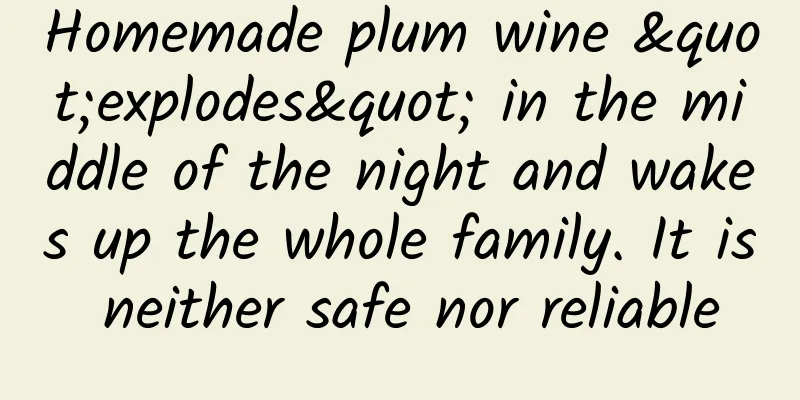Homemade plum wine "explodes" in the middle of the night and wakes up the whole family. It is neither safe nor reliable

|
Audit expert: Wang Guoyi Postdoctoral fellow in Nutrition and Food Safety, China Agricultural University "At noon, the sun is blazing, and the fire is burning." This summer is particularly hot, and many people use sweet and refreshing iced fruit wine as a heat-relief tool. Therefore, with the idea that "homemade wine is more hygienic and safer", under the guidance of various teaching videos, everyone began to use fruit to make wine at home. Source: unsplash Homemade wine safety accidents occur frequently However, "ideals are full, but reality is very skinny". Recently, the plum wine brewed by Aunt Lei, who lives in Yancheng, Jiangsu, exploded at around 4 a.m., waking up the whole family. According to Aunt Lei's description, the raw materials for brewing plum wine are local plums given by relatives. Because there are too many to eat, and they are afraid that it would be a pity to let them rot, they are brewed into plum wine. However, in the bottle, the plums and sugar produce carbon dioxide after fermentation, causing the temperature inside the bottle to rise, and the gas expands but cannot be discharged, which finally causes an explosion. Source | Weibo screenshot In fact, this is not the first time that home brewing has caused an accident. Despite the endless stream of related accidents, there are always people who are eager to try every year and want to "make their own living". On short video platforms such as Douyin, there are many videos related to home brewing with nearly one million likes, and most of the titles are also very eye-catching, such as "Drinking Home Brewed Wine in 30 Days" and "Quick Home Brewing Guide". The operation steps in these videos are simple, giving people the illusion that it is very easy to get started. Source: A shopping website But for novices who have no basic knowledge of brewing, this phenomenon of "half-baked" teaching is obviously not a good thing. Some teaching videos have too simple operation steps, and teach unprofessional knowledge under the banner of "clean, hygienic and simple". Most people who imitate others in front of the screen are prone to mistakes during the actual operation due to the lack of professional equipment and guidance, which often endangers their own health. Tips for Douyin query page Source | Screenshot from TikTok What are the risks of home brewing? The first is the risk of explosion. The fermentation tanks used in regular winery workshops are all made of stainless steel. The external storage environment is stabilized by precisely controlling the temperature, air humidity and other conditions. At the same time, proper exhaust is required during the brewing process to prevent the air pressure in the bottle from being too high and causing an explosion. However, most people use some bottles and jars to hold their own wine when brewing at home. If they lack relevant knowledge or experience and do not release the air in time, the pressure in the jar will be too high and an explosion will occur, endangering personal safety. Source | hippopx Secondly, it is easy to cause bacterial contamination. When most people make their own wine, they will not buy professionally packaged yeast for fermentation, but choose to rely directly on wild yeast attached to the peel. However, wild yeast lacks stability, and there are also various bacteria on the peel, the quantity and quality of which are uncontrollable. It is difficult to control the quality of the wine under the condition of simple equipment, and it is easy to be infected by bacteria. Suitable temperature, as a necessary condition for the growth of microorganisms, needs to be strictly controlled. Most people rely on room temperature changes when making their own wine, so it is easy to breed bacteria. Moreover, most home-made wines use tap water with more microorganisms. Compared with distilled water and purified water, this increases the risk of excessive microorganisms, especially excessive pathogenic bacteria, which will seriously endanger your health. Saccharomyces cerevisiae Source | A shopping website Another problem is that it is easy to cause methanol to exceed the standard . Many people choose to use grapes to make wine, but the cell walls of grapes contain a large amount of pectin, which will produce methanol after pectin esterification. When manufacturers make wine, they will add an appropriate amount of exogenous pectinase to limit the production of methanol. However, due to the lack of corresponding pectinase, home-made wine is more likely to cause methanol to exceed the standard and there is a risk of poisoning, especially when the raw grapes are rotten and the ambient temperature is too high. Source: A shopping website The reason why methanol is easily produced is also related to our choice of raw grapes. The grapes used by manufacturers for winemaking are different from the grapes we usually eat. Winemaking grapes are mostly thick-skinned, dark in color, less juice, and high in sugar. At the same time, we also have certain requirements for the phenolic substances they contain. Most of the grapes we can buy in supermarkets are table grapes. These grapes have thin skins, are juicy, large in size, and have a high water content, but the sugar content is much lower than that of winemaking grapes, so the wine produced will have a sour taste, which is a reflection of the alcohol content not meeting the standard. Wine grapes Source: pixabay In order to balance the sour taste, some people often choose to add sugar to the wine. Sugar has a very strong ability to convert into alcohol. If the dosage is not carefully controlled, excessive sugar will be added, and the resulting wine will have a high alcohol content. This is why home-made wine often has a "strong aftertaste". Incompletely fermented sugar is also prone to bacterial contamination. There is a lot of knowledge in winemaking. In addition to the necessary professional knowledge and technology, it also requires a lot of practical experience and operating skills, as well as professional equipment and instruments, so as to ensure that a bottle of wine is safe and of high quality. Brewing wine is not something you can do by yourself by watching a short video. Once a small mistake occurs during the self-brewing process, it may cause major safety hazards. "Self-brewing is valuable, but safety is more valuable." If you are not a professional, it is not recommended that you brew wine at home. |
<<: Moon dust eaten by cockroaches? There are so many embarrassing things in space travel
>>: Air conditioning was invented to "save you"? Wrong! The truth is...
Recommend
Interesting story | Nitrogen accounts for 78% of the earth, why can humans only absorb oxygen to survive?
The atmosphere is 78% nitrogen and only 21% oxyge...
4,200 years ago, Chinese ancestors were already driving cars?
The Pingliangtai Site in Huaiyang was selected as...
The "holy object" for weight loss and disease treatment actually grows on trees
Mulberry leaves, as the daily food of silkworms, ...
Qian Xuesen named VR "Spiritual Realm", the romance of Chinese culture is all in it
In April 1996, at the Beijing Military Museum, a ...
How to determine the amount of Ligustrum lucidum to drink in water?
In daily life, people use various medicines to co...
The "Roof of the World" was originally a "Valley"! What happened to the Qinghai-Tibet Plateau?
Author: Han Yangmei The Qinghai-Tibet Plateau, th...
The best things in life happen when you are alone
Leviathan Press: Being alone forces you to think ...
What is the difference between Gallic and Schisandra chinensis
Many people tend to confuse gallnut and Schisandr...
Sending 14 cabinets to the sky? What were they thinking?
The Shenzhou-15 crew, including Fei Junlong, Zhan...
The efficacy and function of deer antler glue
The antlers of sika deer and red deer are both tr...
The efficacy and function of false forsythia
Traditional Chinese medicine is a Chinese traditi...
Mid-Autumn Festival is coming. How can children eat mooncakes to satisfy their cravings and stay healthy? Here is the most comprehensive guide!
Mid-Autumn Festival is a traditional festival in ...
The error is no more than 1 second in hundreds of millions of years! Who gave the atomic clock such "terrifying" accuracy?
What is the principle of atomic clocks? How do th...
What is the meaning of "fighting fire with fire" in forest fire rescue? Won't it make the fire bigger?
On May 12, 2023, the Science Popularization China...









